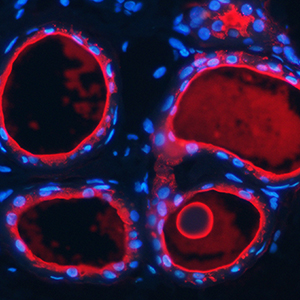 Smart Citations
Smart CitationsSee how this article has been cited at scite.ai
scite shows how a scientific paper has been cited by providing the context of the citation, a classification describing whether it supports, mentions, or contrasts the cited claim, and a label indicating in which section the citation was made.
Differential antigen expression between human apocrine sweat glands and eccrine sweat glands
Bromhidrosis has a great negative impact on personal occupation and social psychology. It is not yet clear whether bromhidrosis is caused by apocrine sweat glands or the co-action of apocrine sweat glands and eccrine sweat glands. To distinguish between apocrine sweat glands and eccrine sweat glands, specific antigen markers for apocrine sweat glands and eccrine sweat glands must be found first. In the study, we detected the expression of K7, K18, K19, Na+-K+-2Cl- cotransporter 1 (NKCC1), carbonic anhydrase II (CAII), Forkhead transcription factor a1 (Foxa1), homeobox transcription factor engrailed homeobox1 (En1), gross cystic disease fluid protein-15 (GCDFP-15), mucin-1 (MUC-1), cluster of differentiation 15 (CD15) and apolipoprotein (APOD) in eccrine sweat glands and apocrine sweat glands by immunofluorescence staining. The results showed that K7, K18, K19, Foxa1, GCDFP-15 and MUC-1 were expressed in both apocrine and eccrine sweat glands, CD15 and APOD were only expressed in apocrine sweat glands, and CAII, NKCC1 and En1 were only expressed in eccrine sweat glands. We conclude that CD15 and APOD can serve as specific markers for apocrine sweat glands, while CAII, NKCC1 and En1 can serve as specific markers for eccrine sweat glands to differentiate the two sweat glands.
Altmetrics
Downloads
Rights
82172231, 82172211, 81830064How to Cite

This work is licensed under a Creative Commons Attribution-NonCommercial 4.0 International License.
PAGEPress has chosen to apply the Creative Commons Attribution NonCommercial 4.0 International License (CC BY-NC 4.0) to all manuscripts to be published.








